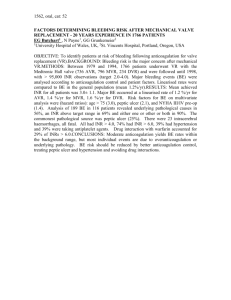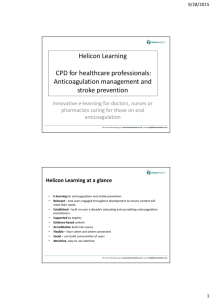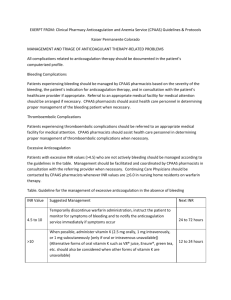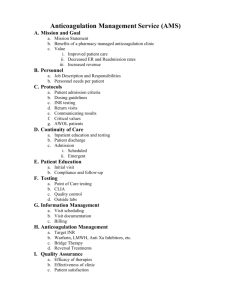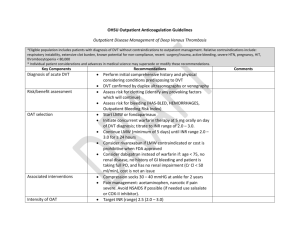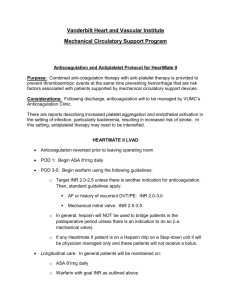L M I
advertisement
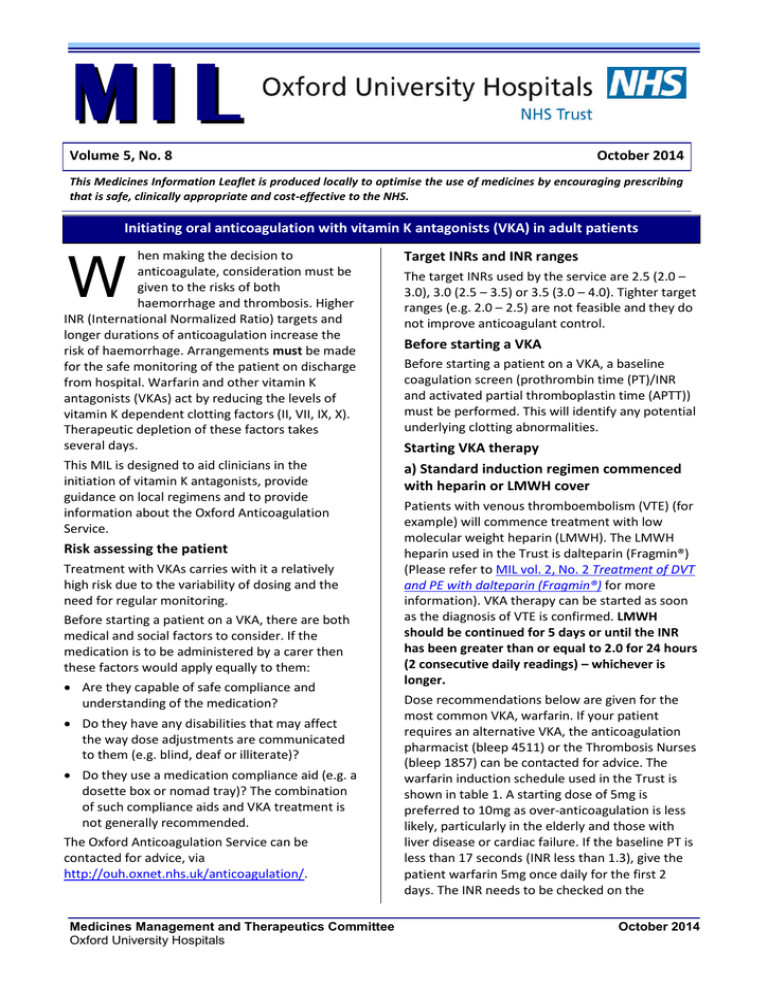
MI L Volume 5, No. 8 October 2014 This Medicines Information Leaflet is produced locally to optimise the use of medicines by encouraging prescribing that is safe, clinically appropriate and cost-effective to the NHS. Initiating oral anticoagulation with vitamin K antagonists (VKA) in adult patients W hen making the decision to anticoagulate, consideration must be given to the risks of both haemorrhage and thrombosis. Higher INR (International Normalized Ratio) targets and longer durations of anticoagulation increase the risk of haemorrhage. Arrangements must be made for the safe monitoring of the patient on discharge from hospital. Warfarin and other vitamin K antagonists (VKAs) act by reducing the levels of vitamin K dependent clotting factors (II, VII, IX, X). Therapeutic depletion of these factors takes several days. This MIL is designed to aid clinicians in the initiation of vitamin K antagonists, provide guidance on local regimens and to provide information about the Oxford Anticoagulation Service. Risk assessing the patient Treatment with VKAs carries with it a relatively high risk due to the variability of dosing and the need for regular monitoring. Before starting a patient on a VKA, there are both medical and social factors to consider. If the medication is to be administered by a carer then these factors would apply equally to them: Are they capable of safe compliance and understanding of the medication? Do they have any disabilities that may affect the way dose adjustments are communicated to them (e.g. blind, deaf or illiterate)? Do they use a medication compliance aid (e.g. a dosette box or nomad tray)? The combination of such compliance aids and VKA treatment is not generally recommended. The Oxford Anticoagulation Service can be contacted for advice, via http://ouh.oxnet.nhs.uk/anticoagulation/. Medicines Management and Therapeutics Committee Oxford University Hospitals Target INRs and INR ranges The target INRs used by the service are 2.5 (2.0 – 3.0), 3.0 (2.5 – 3.5) or 3.5 (3.0 – 4.0). Tighter target ranges (e.g. 2.0 – 2.5) are not feasible and they do not improve anticoagulant control. Before starting a VKA Before starting a patient on a VKA, a baseline coagulation screen (prothrombin time (PT)/INR and activated partial thromboplastin time (APTT)) must be performed. This will identify any potential underlying clotting abnormalities. Starting VKA therapy a) Standard induction regimen commenced with heparin or LMWH cover Patients with venous thromboembolism (VTE) (for example) will commence treatment with low molecular weight heparin (LMWH). The LMWH heparin used in the Trust is dalteparin (Fragmin®) (Please refer to MIL vol. 2, No. 2 Treatment of DVT and PE with dalteparin (Fragmin®) for more information). VKA therapy can be started as soon as the diagnosis of VTE is confirmed. LMWH should be continued for 5 days or until the INR has been greater than or equal to 2.0 for 24 hours (2 consecutive daily readings) – whichever is longer. Dose recommendations below are given for the most common VKA, warfarin. If your patient requires an alternative VKA, the anticoagulation pharmacist (bleep 4511) or the Thrombosis Nurses (bleep 1857) can be contacted for advice. The warfarin induction schedule used in the Trust is shown in table 1. A starting dose of 5mg is preferred to 10mg as over-anticoagulation is less likely, particularly in the elderly and those with liver disease or cardiac failure. If the baseline PT is less than 17 seconds (INR less than 1.3), give the patient warfarin 5mg once daily for the first 2 days. The INR needs to be checked on the October 2014 2 Medicines Information Leaflet mornings of days 3 and 4 and the dose adjusted according to the regimen in Table 1. Table 1: Standard warfarin induction regimen Days 1 & 2 Give 5mg each evening if baseline INR less than or equal to 1.3 Day 3 Day 4 INR Dose INR Dose <1.5 10mg <1.6 10mg 1.5-2.0 5mg 1.6-1.7 7mg 2.1-2.5 3mg 1.8-1.9 6mg 2.6-3.0 1mg 2.0-2.3 5mg >3.0 0mg 2.4-2.7 4mg 2.8-3.0 3mg 3.1-3.5 2mg 3.6-4.0 1mg >4.0 0mg The dose at day 4 should be a predictor of the maintenance dose in most patients. Beyond day 4, clinical judgment should be used to adjust doses. A member of the Thrombosis Team can be contacted for advice. Duration of therapy for patients with VTE Patients with proximal DVT or PE should be treated for at least 3 months. An analysis of data from seven trials concluded that three months of treatment achieves a similar risk of recurrent venous thromboembolism after stopping anticoagulation as a longer course of treatment. It is clear that patients with unprovoked proximal DVT or PE are at a higher risk of recurrence than those with a transient precipitating factor and it is therefore recommended that they should be considered for long-term anticoagulation. b) Slow induction of anticoagulation in patients with atrial fibrillation, AF (without heparin cover) Such patients can be commenced on a slow loading regimen without LMWH heparin cover (NB if they are an inpatient, they may be on prophylactic LMWH – this should be continued as per Trust protocol). If the baseline INR is less than or equal to 1.3 (PT less than 17 seconds) the usual starting dose is 3mg warfarin daily. The INR should be checked in 4 – 7 days. For more information on anticoagulation in AF patients, please refer to MIL Vol. 8, No. 5 ‘Atrial fibrillation and Anticoagulation Management’ Patient (or carer) counselling It is imperative that all patients new to VKA treatment are offered verbal counselling and supporting printed information at the start of their therapy. Patient (or carer) understanding is vital to the effectiveness of therapy with VKAs. Ideally, counselling should be given by the ward pharmacist while the patient is still in hospital. Patients should also be offered an appointment at the New Patient Clinic at the Churchill Hospital where they can receive further counselling by a specialist anticoagulation nurse. Referring patients to the Anticoagulation Clinic As soon as possible after starting VKA therapy (usually on the first working day after commencement of therapy), all new patients must be referred to the Anticoagulation Clinic at the Churchill Hospital to initiate remote postal dosing. This is a telephone referral via bleep 1857. Full details of the referral procedure are available via http://ouh.oxnet.nhs.uk/anticoagulation. For patients who are not covered by the Oxford Anticoagulation Service, a referral must be made to the patient’s GP or local Anticoagulation Service. The Thrombosis Nurses (bleep 1857) will be able to help with this. Monitoring VKA therapy Clinical judgment is required when deciding the interval between INR measurements. When adjusting doses it should be borne in mind that it takes up to a week for the full effect of any dose change to be seen. The INR should be monitored more frequently when interacting medication is co-prescribed and should be measured 5 – 7 days after any changes in medication. Interactions Many medications, supplements and foods interact with VKA therapy. Additional INR monitoring is recommended when any changes are made to a patient’s medication regimen. Some of the more significant interacting medicines are co-trimoxazole, carbamazepine, rifampicin, ciprofloxacin, erythromycin, barbiturates & amiodarone. For a full list of interacting medicines, please see the latest edition of the BNF. 3 Medicines Information Leaflet Discharging a patient on VKA therapy Before discharging a patient on VKA therapy, follow up arrangements for INR monitoring must be confirmed. For all patients ensure each of the following steps are done: 1. The anticoagulation section of the TTO is fully completed 2. The TTO is fully published 3. A verbal referral is made All patients must be given the supporting printed information about their VKA therapy (“Important information for patients on anticoagulation with vitamin K antagonists”). These booklets are available in clinical areas and from pharmacy. The first appointment for an INR check should usually be within the first 48 hours after discharge. Please do not request routine post-discharge INR tests for a Friday, Saturday, Sunday or Bank Holiday. If there is a clinical need for the INR to be measured on one of these days, please contact the Anticoagulation Service (bleep (JR) 1857) for advice. Patients new to VKA and still on LMWH Patients new to VKA therapy who are still on LMWH at discharge cannot be accepted by the Anticoagulation Service. However, to facilitate discharge, the patient may be accepted by the DVT clinic for short term management (bleep 5165). Management of overdose Separate guidance has been produced for the management of elevated INRs. Please refer to MIL vol. 5 No. 9 Reversal of oral anticoagulation in adult Inpatients. The Oxford Anticoagulation Service The Oxford Anticoagulation Service operates a “dose & post” service for most GP surgeries in Oxfordshire. The Service operates 9am – 5pm, Monday to Friday (excluding Bank Holidays). For more information and a referral form, please see http://ouh.oxnet.nhs.uk/anticoagulation. References 1. “Oxford Haemophilia & Thrombosis Centre Protocols for Anticoagulation with Vitamin K Antagonists” version 3.2. May 2013. David Keeling 2. “Guidelines on oral anticoagulation (warfarin) 4th Edition” D.M. Keeling et al Br J Haematol, 2011. 154, 311-324 3. “Antithrombotic therapy for venous thromboembolic disease: American College of Chest Physicians evidence based clinical practice guidelines (9th Edition) Guyett, GH et al Chest 141 supplement 2012 4. “Venous thromboembolic diseases: the management of venous thromboembolic diseases and the role of thrombophilia testing” NICE CG144, June 2012 5. British National Formulary (BNF) 66th Edition. British Medical Association and the Royal Pharmaceutical Society of Great Britain, London, UK. March 2014 Prepared by: Vicki Price, Lead Anticoagulation Pharmacist and Dr David Keeling, Haematology Consultant on behalf of OUH Anticoagulation & Thrombosis Team Review date: October 2017
